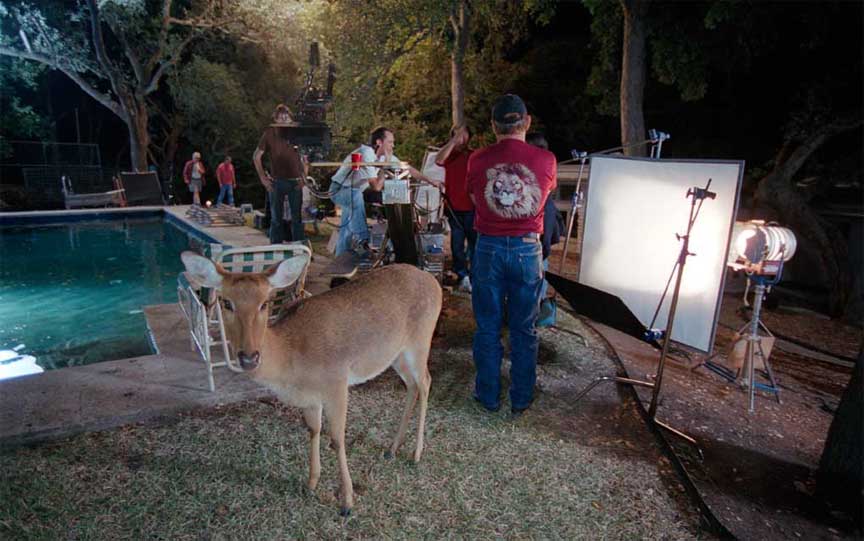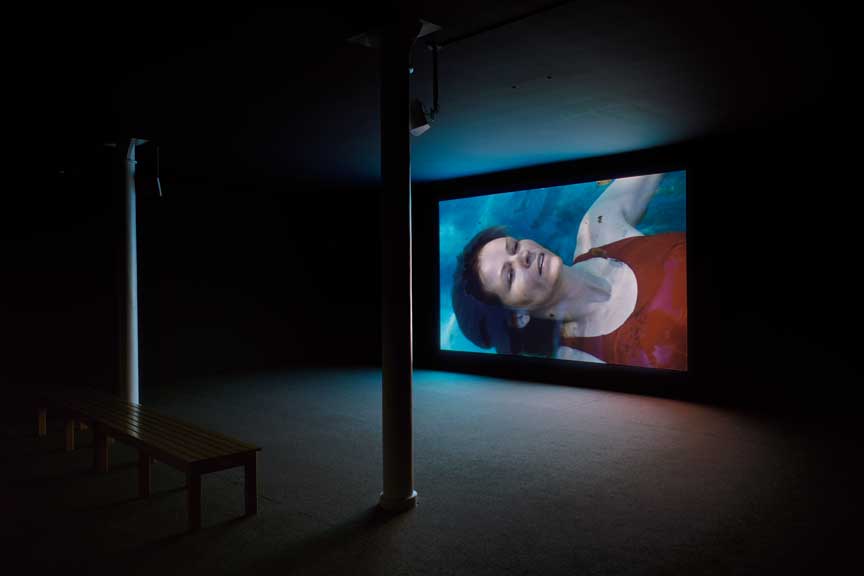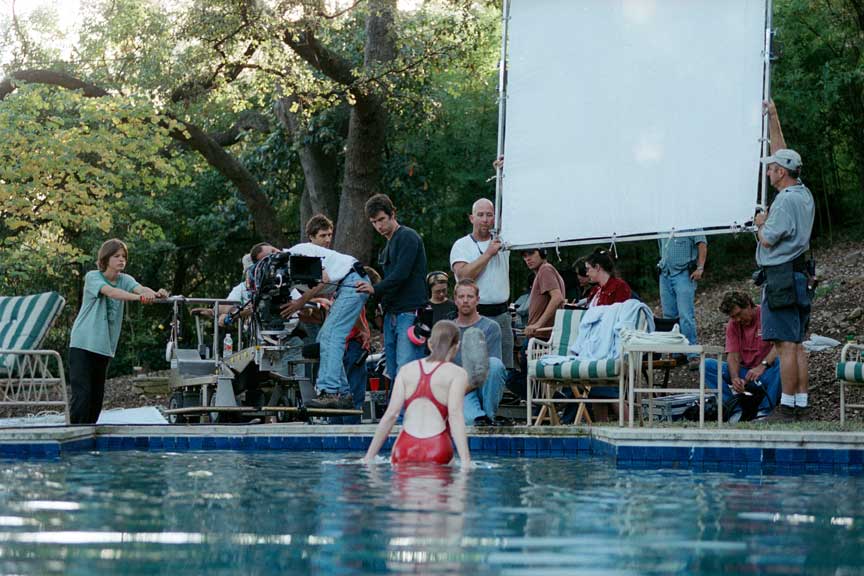Interview
Place and Persona

Hubbard/Birchler. House with Pool, production still, 2004. High Definition Video with sound transferred to DVD 20 min 39 sec, loop. Photo by Bill Records . Courtesy of the artists and Tanya Bonakdar Gallery, New York.
Artists Teresa Hubbard and Alexander Birchler discuss the exploration of place in their work.
ART21: You seem to have such a curiosity about places.
BIRCHLER: I think it’s important to understand that Teresa and I—we’re not from the same place. It’s very difficult to find a place where we both fit in. Our work becomes almost like our third persona because we collaborate. So, we always try to find a place for that persona—this third place where we both have the same investment in terms of relation or attachment, or dis-attachment. Because we felt that, in places where one of us is much more “there” than the other, it was always difficult because one person was less integrated than the other one, and that created an imbalance. And it’s always been the work that we produce in a place that’s part of the process of putting down roots—integration is maybe too strong a word—but just a kind of dialogue with the place.
ART21: The types of places your work depicts are diverse.
BIRCHLER: It probably points out exactly that contrast we’re interested in—that we can, or that we do, make a work about this trailer home. Then, a year later, we make a work about this upscale, suburban kind of modernist house. We’re interested in these two stories because they are very close to our experience. The place where we shot Single Wide is about ten miles, five miles, from our studio. We drove there every day. And the house that we chose for House with Pool is the house of a collector that we met in the process of finding a location. So, both of these worlds seem to be part of our everyday experience and maybe more specifically about where we live right now. But we’ve always tried to make work about where we live.

Hubbard/Birchler. House with Pool, 2004. High Definition Video with sound transferred to DVD
20 min 39 sec, loop. Installation at Tanya Bonakdar Gallery, New York. Courtesy of the artists and Tanya Bonakdar Gallery, New York.
ART21: Do you think of yourselves as Americans?
HUBBARD: Once I bristled because someone who had written about our work without researching it painted us as these foreigners with patriotic undertones—that we make this work about American life, but we’re foreigners. I thought that was really annoying.
BIRCHLER: I think we will bristle if people make a judgment and say that we’re not allowed to make work about what we see in front of our doorstep. I do consider myself an American artist, or even a Texan artist, or an Austin artist because that’s just the way it is.
HUBBARD: We moved here at the end of 2000. I think, regarding nationality, being an American artist is as complicated as the United States is. Most of the artists that we know working over here—their cultural, social identities are greatly informed from some other place, some other culture. That’s the beauty of it.
BIRCHLER: In our work, there is this element of everyplace. It’s not the reason why the protagonists don’t speak, but it lends itself to that reading. They become multilingual in their silence. There is enough openness, in terms of where exactly this place is—it’s not designated with signs or words or language—so this everyplace is in the work. Even though you say you recognize a very specific place, and even though we draw our ideas from just in front of our doorstep, we quite consciously try to make this place a non-place or an everyplace, as much as one can make an everyplace about something very specific. And because it’s sort of about this non-place, it’s much more like the memory of a place or the idea of a place.
I don’t think that you can make work in Texas that moves a Texan person and a Swiss person in the same way. These are huge cultural differences. But I think the sense of frustration these woman have—the sense of repetition—that is something that everyone can relate to. You read only a certain amount of her, of her story. What is her social status? How much is she tied to that social status? How long has she been living in these conditions? Can she get out of this condition?

Hubbard/Birchler. House with Pool, production still, 2004. High Definition Video with sound transferred to DVD
20 min 39 sec, loop. Photo by Shaune Kolber. Courtesy of the artists and Tanya Bonakdar Gallery, New York.
ART21: Can you say something about the high production value of your work?
HUBBARD: We come from photography, large-scale photography, using large-format cameras. And part of how we thought of these works in the beginning was that we referred to them as long photographs. And coming from photography, we’ve also been very attached to taking Polaroids before and during a shoot, to see where we’re at. So, in one sense, turning to high definition was about wanting a photographic, filmic look but having the immediacy on set to see what it is that we’re actually getting.
It’s quite practical in one sense, and also because of where we are—because it’s such a vibrant place for film and video—finding expertise in high-def was viable when we were weighing what kind of medium we wanted and needed. I want to imbue the shots, in some sense, with quite a conscious intensity, both with the camera work and the color—with heightened consciousness of both those elements. And this idea that the story has a shape, and every second I’m acknowledging that with the language of the camera and the vocabulary of the shots. It’s not to say that it’s always going to be that way, but for the ideas and the shapes of the story so far, it’s needed to be that way.



